MATH 211: Mathematician of the Day
Each day we note a mathematician whose contributions bear on the subject matter
of the day's material. Below is a listing of previous winners of the coveted
Mathematician of the Day award.
- DATE
-
- 8/27: Rene Descartes (1596-1650).
-

- Introduced current notation for
symbolically describing the connections between equations and graphs.
- 8/29: Pythagoras (ca.580 BC-ca.520 BC) and Euclid (ca.365 BC-ca.300 BC).
-

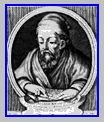
-
Pythagoras is considered the first ``real" mathematician. He and his followers
proved many of the fundamental results of geometry. Euclid is best known for his
treatise on geometry, The Elements. Here, he assimilated for the first time
the known results of geometry from antiquity.
- 9/3: John Napier (1550-1617).
-

- Scottish part-time mathematician who
developed logarithms.
- 9/5: Leonhard Euler (1707-1783).
-

- The first to use the concept of
``function" consistently in analysis, and the first to formulate the ideas of
calculus in terms of functions. Euler also introduced much of the notation that
we use today, including the Greek letter pi for the ratio of the
circumference to the diameter of a circle, i for the imaginary unit,
and e for the base of the natural logarithm.
- 9/10: Charles Babbage (1792-1871).
-

- Invented the principle of the
analytical engine, the forerunner of the modern digital computer.
- 9/12: Johann Bernoulli (1667-1748).
-
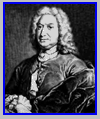
- Bernoulli was the mathematician behind
the first calculus textbook, ``Analyse des infiniment petits"
(``Analysis of the Infinitely Small"), by l'Hopital.
- 9/19: Pierre de Fermat (1601-1665).
-
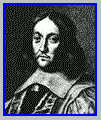
- French lawyer and city councilman who
studied mathematics as a hobby. Fermat proposed the idea of attaching tangent lines
to graphs, and approximating the slope of a tangent line via secant lines, although
his approach was not given in terms of limits, as we use now. Fermat also used
tangent lines to determine local maximum and minimum values of graphs; his
method was essentially the same that we use today.
- 9/24: Sir Isaac Newton (1642-1727).
-

- Co-developer of calculus.
- 9/26: Augustin Louis Cauchy (1789-1857).
-

- First mathematician to make
consistent use of limits to describe the ideas of calculus.
- 10/1: Joseph Louis Lagrange (1736-1813).
-

- First stated and proved the
Mean Value Theorem.
- 10/3: Gottfried Wilhelm von Leibniz (1646-1716).
-

- Co-developer of
calculus. During a visit to France, Leibniz became aquainted with the work
of Descartes, Fermat, and others. He developed these ideas, independently
of Newton, into calculus. Leibniz thought of calculus in terms of analysis,
whereas Newton subscribed to a more geometrical perspective. For example,
Leibniz described the definite integral in terms of sums, while Newton
interpreted the definite integral as the area of a plane region. Leibniz
is also responsible for introducing much of the modern calculus notation.
- 10/8: Georg Friedrich Bernhard Riemann (1826-1866).
-

- Clarified the
notion of a definite integral by defining it precisely as a limit of sums,
which have come to be called Riemann sums.
- 10/10: Archimedes (287 BC-212 BC) and Hippocrates (ca. 470 BC-ca. 410 BC).
-
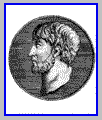
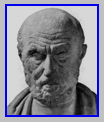
- Archimedes is considered by many to be the greatest mathematician of
ancient times. Both he and Hippocrates worked (independently, of course, since
they lived about 200 years apart!) on the problem of
determining the areas of nonstandard geometric regions by relating them to
geometric shapes, such as triangles or rectangles, of known area.
- 10/17: Sir Isaac Barrow (1630-1677).
-

- Newton's teacher at Cambridge,
Barrow was the first to recognize differentiation and integration as inverse
operations. It was on Barrow's ideas that Newton (and probably Leibniz also)
based the Fundamental Theorem of Calculus.
- 10/22: Nicole Oresme (1323-1382).
-
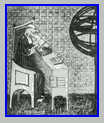
- Had some notion of functional
relationship between quantities (e.g. velocity as a function of time),
and proposed graphing such relationships. (This was done more than 200 years
before Descartes was even born!) Oresme described a conceptual process of
integration, or ``continuous summation,'' to calculate distance traveled
as area under the velocity-time graph.
- 10/29: Johann Hudde (1628-1704).
-
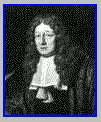
- Discovered Hudde's Rule, which
essentially gives formula for the derivative of a polynomial. Hudde did this
algebraically, with no notion of limits or infinitely small quantities.
- 10/31: Bhaskara (1114-1185).
-

- Hindu mathematician and astronomer, who
was interested in the concept of instantaneous motion of planets. In the
course of his studies, he discovered what came to be known as the formula
for the derivative of the sine function.
- 11/5: Al'Khwarizmi (ca. 790-ca. 850) and Omar Khayyam (1048-1122).
-

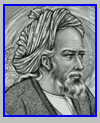
- Two
prominent mathematicians of the medieval and pre-medieval period in the
Middle East. During this time, the geometric ideas of the ancient Greek
mathematicians were preserved and blended with the more algebraic ideas of
the mathematicians of ancient India. It is from Al'Khwarizmi's name that
the term algorithm was derived, and the title of one of his books
includes the word al-jabr, from which the term algebra arose.
Khayyam was a poet as well as a scientist, and authored the well-known
book of four-line poems known as the Rubaiyat.
- 11/7: Karl Weierstrass (1815-1897).
-
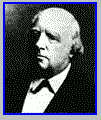
- Among many other achievements,
proved that a continuous function on a closed and bounded interval always
has maximum and minimum values.
- 11/12: Francois Viete (1540-1603).
-
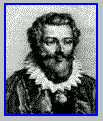
- Introduced the first systematic algebraic notation, and was a major
influence on Descartes. Viete used vowels to represent variables and
consonants to represent constants. The current practice of using letters at
the end of the alphabet for variables and letters at the beginning of
the alphabet for constants was introduced by Descartes. Also, Viete was
one of the first to recognize the formula for an antiderivative of x^n.
- 11/14: Alan Turing (1912-1954).
-

-
- 11/19: George Berkeley (1685-1753).
-

- An Irish theologian who criticized the logical foundation of Newton's
calculus. This motivated a number of mathematicians (including some
former "Mathematicians of the Day") to attempt to develop the concepts
of calculus in a more rigorous way.
- 11/26: Carl Friedrich Gauss (1777-1855).
-
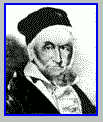
- Generally considered the
greatest mathematical genius who ever lived.
- 12/3: Bonaventura Cavalieri (1598-1647).
-
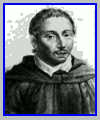
- Developed a method of "indivisibles", which was a way of calculating
the area of geometric figures using lots of tiny simple geometric shapes.
This was a major influence on Leibniz and the development of integral
calculus.
- 12/5: Charles Lutwidge Dodgson (1832-1898).
-

- Wrote some mathematics books, including "Euclid and His Modern Rivals."
Best known, however, for books written under his pseudonym, "Lewis Carroll".























































